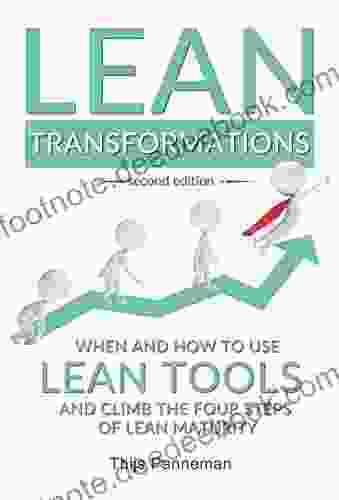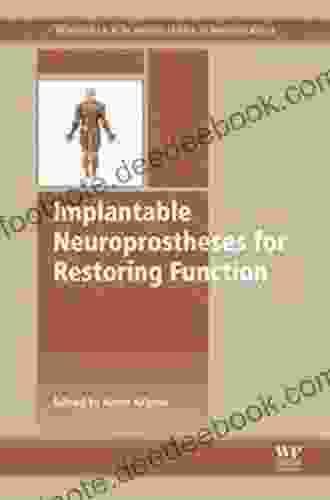Implantable Neuroprostheses for Restoring Function: An Comprehensive Guide

Implantable neuroprostheses are devices that are implanted into the nervous system to restore function or improve quality of life for individuals with disabilities or injuries. They work by interfacing with the natural nervous system and providing electrical stimulation or recording of neural signals. Neuroprostheses have the potential to revolutionize the treatment of a wide range of conditions, including stroke, spinal cord injury, Parkinson's disease, and epilepsy.
5 out of 5
| Language | : | English |
| File size | : | 12288 KB |
| Text-to-Speech | : | Enabled |
| Enhanced typesetting | : | Enabled |
| Print length | : | 426 pages |
| Screen Reader | : | Supported |
| Paperback | : | 146 pages |
| Item Weight | : | 7.2 ounces |
| Dimensions | : | 6 x 0.35 x 9 inches |
Types of Implantable Neuroprostheses
There are two main types of implantable neuroprostheses:
* Motor neuroprostheses are designed to restore movement to individuals with paralysis. They work by stimulating muscles or nerves to produce movement. * Sensory neuroprostheses are designed to restore sensory function to individuals who have lost it due to injury or disease. They work by stimulating the nerves that transmit sensory information to the brain.
Motor neuroprostheses can be further classified into two types:
* Invasive neuroprostheses are implanted directly into the nervous system. They are typically used to treat severe paralysis, such as that caused by spinal cord injury. * Non-invasive neuroprostheses are placed on the surface of the nervous system. They are typically used to treat less severe paralysis, such as that caused by stroke.
Sensory neuroprostheses can also be classified into two types:
* Invasive sensory neuroprostheses are implanted directly into the nervous system. They are typically used to treat severe sensory loss, such as that caused by deafness or blindness. * Non-invasive sensory neuroprostheses are placed on the surface of the nervous system. They are typically used to treat less severe sensory loss, such as that caused by tinnitus or chronic pain.
Applications of Implantable Neuroprostheses
Implantable neuroprostheses have a wide range of applications, including:
* Restoring movement to individuals with paralysis caused by stroke, spinal cord injury, or other conditions. * Improving sensory function in individuals who have lost it due to deafness, blindness, or other conditions. * Treating chronic pain by stimulating nerves to block pain signals. * Controlling movement disorders such as Parkinson's disease and dystonia by stimulating the brain or spinal cord. * Improving cognitive function in individuals with dementia or other cognitive disorders.
Benefits of Implantable Neuroprostheses
Implantable neuroprostheses offer several benefits over traditional treatments for disabilities and injuries. These benefits include:
* Improved quality of life by restoring function and independence. * Reduced pain by blocking pain signals. * Improved mobility by facilitating movement. * Enhanced communication by restoring sensory function. * Increased independence by allowing individuals to perform activities of daily living without assistance.
Challenges of Implantable Neuroprostheses
Implantable neuroprostheses are complex devices that can be difficult to design, develop, and implant. Some of the challenges associated with neuroprostheses include:
* Biocompatibility: Neuroprostheses must be made of materials that are compatible with the human body and do not cause inflammation or rejection. * Durability: Neuroprostheses must be able to withstand the harsh conditions of the nervous system and function for extended periods of time. * Power supply: Neuroprostheses require a power supply to operate. This can be a challenge for devices that are implanted deep within the body. * Signal processing: Neuroprostheses must be able to process neural signals and translate them into commands that can be understood by the device. * Cost: Implantable neuroprostheses are expensive to design, develop, and implant. This can limit their availability to patients.
Future Prospects for Implantable Neuroprostheses
Implantable neuroprostheses are a rapidly evolving field. Researchers are working to develop new devices that are more effective, less invasive, and more affordable. Some of the future prospects for neuroprostheses include:
* Closed-loop neuroprostheses that can sense and respond to changes in the nervous system. This will allow neuroprostheses to be more adaptive and personalized. * Wireless neuroprostheses that can be powered and controlled wirelessly. This will eliminate the need for cables and connectors, which can be a source of infection. * Miniaturized neuroprostheses that can be implanted with less invasive procedures. This will make neuroprostheses more accessible to patients.
Implantable neuroprostheses offer great potential for restoring function and improving quality of life for individuals with disabilities or injuries. However, there are still many challenges that need to be overcome before neuroprostheses can become widely available. With continued research and development, neuroprostheses have the potential to revolutionize the treatment of a wide range of conditions.
5 out of 5
| Language | : | English |
| File size | : | 12288 KB |
| Text-to-Speech | : | Enabled |
| Enhanced typesetting | : | Enabled |
| Print length | : | 426 pages |
| Screen Reader | : | Supported |
| Paperback | : | 146 pages |
| Item Weight | : | 7.2 ounces |
| Dimensions | : | 6 x 0.35 x 9 inches |
Do you want to contribute by writing guest posts on this blog?
Please contact us and send us a resume of previous articles that you have written.
 Page
Page Chapter
Chapter Story
Story Genre
Genre Reader
Reader Library
Library Paperback
Paperback Newspaper
Newspaper Paragraph
Paragraph Glossary
Glossary Foreword
Foreword Preface
Preface Annotation
Annotation Footnote
Footnote Manuscript
Manuscript Scroll
Scroll Codex
Codex Tome
Tome Classics
Classics Library card
Library card Biography
Biography Narrator
Narrator Character
Character Resolution
Resolution Librarian
Librarian Catalog
Catalog Card Catalog
Card Catalog Stacks
Stacks Archives
Archives Periodicals
Periodicals Scholarly
Scholarly Lending
Lending Reserve
Reserve Academic
Academic Reading Room
Reading Room Dissertation
Dissertation Storytelling
Storytelling Reading List
Reading List Book Club
Book Club Textbooks
Textbooks William Mccauley
William Mccauley Kirstin Chen
Kirstin Chen Mike Damante
Mike Damante Tony Kushner
Tony Kushner Michael J Graetz
Michael J Graetz Lea Rawls
Lea Rawls Emma Friedlander Collins
Emma Friedlander Collins James Dashner
James Dashner Nicole Wilde
Nicole Wilde Angie Salisbury
Angie Salisbury Michael Kirby
Michael Kirby Rahul Raina
Rahul Raina Jon Cohen
Jon Cohen Stuart Taylor
Stuart Taylor Mordecai Roshwald
Mordecai Roshwald Vicki Lockwood
Vicki Lockwood Kimberly Brubaker Bradley
Kimberly Brubaker Bradley Wilfredo Alvarez
Wilfredo Alvarez C L Hoang
C L Hoang Martha Buelt
Martha Buelt
Light bulbAdvertise smarter! Our strategic ad space ensures maximum exposure. Reserve your spot today!

 Kelly BlairTennessee Tails: Pets and Their People, a Tail-Wagging Adventure in the Heart...
Kelly BlairTennessee Tails: Pets and Their People, a Tail-Wagging Adventure in the Heart...
 Efrain PowellAn Extraordinary Canine: The Inspiring Story of Dog Called Valentine Roxanne...
Efrain PowellAn Extraordinary Canine: The Inspiring Story of Dog Called Valentine Roxanne... Danny SimmonsFollow ·5.3k
Danny SimmonsFollow ·5.3k Ervin BellFollow ·12.4k
Ervin BellFollow ·12.4k VoltaireFollow ·15.8k
VoltaireFollow ·15.8k Yukio MishimaFollow ·13.8k
Yukio MishimaFollow ·13.8k Dashawn HayesFollow ·6.7k
Dashawn HayesFollow ·6.7k Tim ReedFollow ·12.4k
Tim ReedFollow ·12.4k Devin RossFollow ·9.7k
Devin RossFollow ·9.7k Rob FosterFollow ·9k
Rob FosterFollow ·9k

 Allen Ginsberg
Allen GinsbergUnveiling the True Meaning of Enough: A Comprehensive...
: In the relentless pursuit of progress and...

 Clay Powell
Clay PowellHawker Hunter: The Jet Fighter that Shaped British...
Nestled in the halls of aviation...

 Alec Hayes
Alec HayesWhen and How to Use Lean Tools and Climb the Four Steps...
Lean is a management...

 Trevor Bell
Trevor BellVolume of Charlotte Mason Original Homeschooling: A...
Charlotte Mason's original...

 John Parker
John ParkerAscending Tristan da Cunha: A Comprehensive Guide to...
Prepare yourself for an extraordinary journey...
5 out of 5
| Language | : | English |
| File size | : | 12288 KB |
| Text-to-Speech | : | Enabled |
| Enhanced typesetting | : | Enabled |
| Print length | : | 426 pages |
| Screen Reader | : | Supported |
| Paperback | : | 146 pages |
| Item Weight | : | 7.2 ounces |
| Dimensions | : | 6 x 0.35 x 9 inches |










